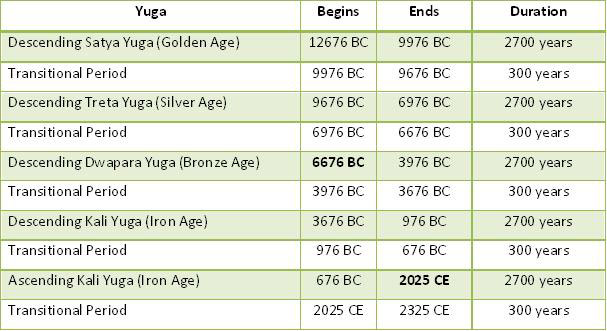The Yuga Cycle doctrine tells us that we are now living in the Kali Yuga; the age of darkness, when moral virtue and mental capabilities reach their lowest point in the cycle. The Indian epic The Mahabharata describes the Kali Yuga as the period when the “World Soul” is Black in hue; only one quarter of virtue remains, which slowly dwindles to zero at the end of the Kali Yuga. Men turn to wickedness; disease, lethargy, anger, natural calamities, anguish and fear of scarcity dominate. Penance, sacrifices and religious observances fall into disuse. All creatures degenerate. Change passes over all things, without exception.
The Kali Yuga (Iron Age) was preceded by three others Yugas: Satya or Krita Yuga (Golden Age), Treta Yuga (Silver Age) and the Dwapara Yuga (Bronze Age). In the Mahabharata, Hanuman gives the following description of the Yuga Cycle to the Pandava prince Bhima:
"The Krita Yuga was so named because there was but one religion, and all men were saintly: therefore they were not required to perform religious ceremonies… Men neither bought nor sold; there were no poor and no rich; there was no need to labour, because all that men required was obtained by the power of will…The Krita Yuga was without disease; there was no lessening with the years; there was no hatred, or vanity, or evil thought whatsoever; no sorrow, no fear. All mankind could attain to supreme blessedness. The universal soul was White… the identification of self with the universal soul was the whole religion of the Perfect Age.
In the Treta Yuga sacrifices began, and the World Soul became Red; virtue lessened a quarter. Mankind sought truth and performed religious ceremonies; they obtained what they desired by giving and by doing.
In the Dwapara Yuga the aspect of the World Soul was Yellow: religion lessened one-half. The Veda was divided into four parts, and although some had knowledge of the four Vedas, others knew but three or one. Mind lessened, Truth declined, and there came desire and diseases and calamities; because of these men had to undergo penances. It was a decadent Age by reason of the prevalence of sin.”
And now we are living in the dark times of the Kali Yuga, when goodness and virtue has all but disappeared from the world.
The whole cycle lasts 24,000 years and consists of 12,000 years of descending movement - decadence, when the level of spirituality of mankind is gradually falling, and 12 00 years of ascending movement - development and rising, when the level of spirituality is growing. Below is a calendar of the Yugas, based on a comparison of various sources of myths and legends in different world cultures and traditions.

According to the Yuga Cycle doctrine, the transitional periods between Yugas are always associated with a worldwide collapse of civilizations and severe environmental catastrophes, which wipe out virtually every trace of any human civilization. The new civilization that emerges in the new Yuga is guided by a few survivors of the cataclysm, who carry with them the technical and spiritual knowledge of the previous epoch. Many ancient sources tell us of the enigmatic group of “Seven Sages” (“Saptarsi”) who are said to appear at the beginning of every Yuga and promulgate the arts of civilization. We find them in myths from across the world – in Sumeria, India, Polynesia, South America and North America. They possessed infinite wisdom and power, could travel over land and water, and took on various forms at will. Were they the survivors of the previous Yuga or visitors from outer space? Opinions differ on this point, but surely neither option can be discarded without proper scrutiny. In any case, the main point is that the transitional periods between Yugas must necessarily correlate with the severe cataclysmic events that regularly impact our planet, as reflected in the archeological records.
The article is based on Bibhu Dev Misra research.

 Рус
Рус

